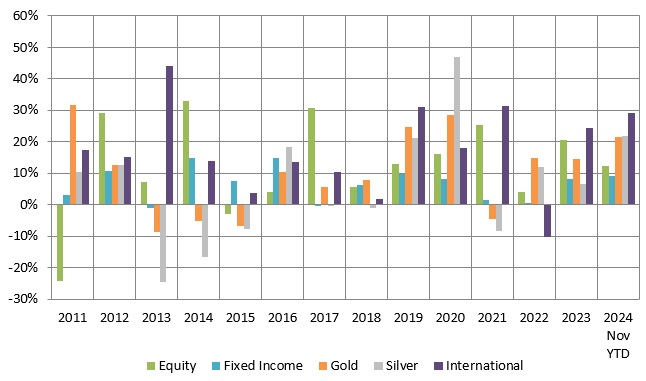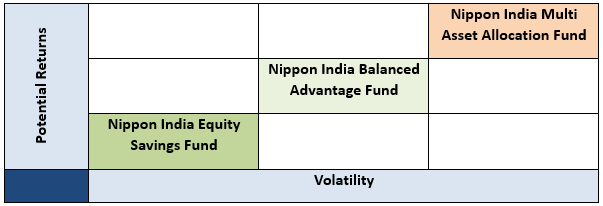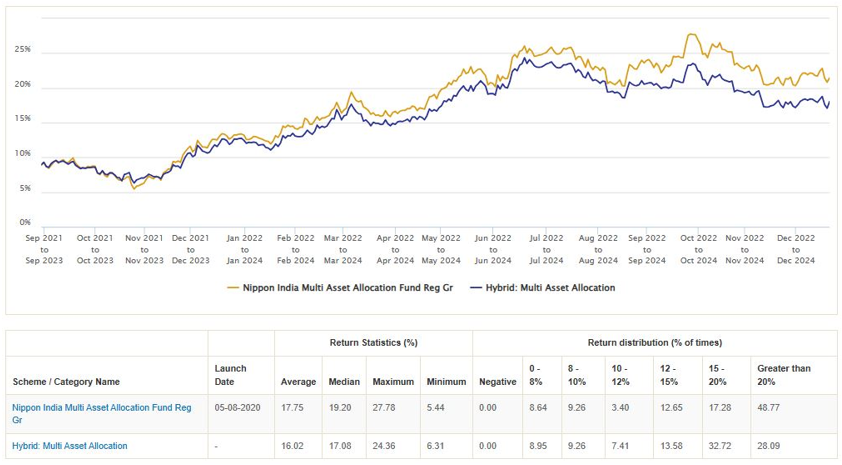Going hybrid in the current environment

Market context
The market has been volatile for the last few months. The Nifty bounced back from 23,500 but has again slipped below the psychologically important 24,000 level after the US Federal Reserve indicated fewer rate cuts in 2025. The correction has brought Nifty valuation below the long-term average PE (see chart below). However, there are several headwinds for the Indian equities namely cut in FY 2025 GDP growth forecast by the RBI, concerns about corporate earnings outlook, uncertainty about rate cuts, strong US Dollar and FII selling. In such uncertain market conditions, asset allocation can play an important role in bringing stability to your investment portfolio. Through judicious asset allocation investors can balance risk and return to achieve their financial goals.

Source: National Stock Exchange, Advisorkhoj, as on 25th December 2024. PE ratios are based Trailing Twelve Months (TTM) Earnings per Share (EPS).
How asset allocations work in market cycles
Different asset classes have low or even negative correlation of returns in different investment cycles (see the chart below). Diversifying your investments across asset classes will bring stability to your portfolio and improve consistency i.e. if one asset class underperforms, the outperformance of another asset class will balance the risks.

Source: National Stock Exchange, MCX, Advisorkhoj Research, 01.01.2011 to 30.11.2024. Equity: Nifty 50 TRI; Fixed: Nifty 10-year benchmark G-Sec Index; Gold: INR price of Gold (MCX), Silver: INR price of Silver (MCX). Disclaimer: Past performance may or may not be sustained in the future. The chart above is purely for investor education purposes and should not construed as investment recommendation.
Since the equity market is going through a volatile phase, hybrid funds like balanced advantage funds, multi asset allocation funds, equity savings funds etc. can add stability and diversification to your investment portfolio.
In this article, we will discuss about 3 different hybrid funds offered by Nippon India Mutual fund – Nippon India Equity Savings Fund, Nippon India Balanced Advantage Fund and Nippon India Multi Asset Allocation Fund which provides asset allocation solutions to investors of different risk appetites and investment needs.
Select funds according to your risk appetite
Different hybrid funds have different risk return profiles. You should select a fund based on your risk appetite. Consult your financial advisor if you need help in understanding your risk appetite and which fund can be suitable for your risk profile and investment needs -

Nippon India Equity Savings Fund
Equity savings funds can partially hedge their equity allocation using derivatives, while maintaining gross equity allocation of at least 65% - thus these funds enjoy equity taxation. These funds must invest at least 10% of their assets in debt and money market instruments. The asset allocation of Nippon India Equity Savings Fund is as follows:-
- Equity Allocation – The net equity (unhedged equity) allocation of the fund can range from 25 – 40%. The equity portion will have high active share (minimum 60%) and have a large cap bias (minimum 65%). It invests across industry sectors.
- Arbitrage Allocation – The fund allocates 25 – 70% to arbitrage opportunities. Arbitrage allocation reduces risk and ensures equity taxation for the fund.
- Debt allocation – The debt allocation of the fund can range from 10 – 35%. The modified duration of the debt portion is maintained between 2 – 4 years (moderate interest rate risk). The credit quality is high.
The chart below shows the drawdowns of Nippon India Equity Savings Fund versus Nifty 50 TRI over the last 3 years. You can see that the Nippon India Equity Savings Fund experienced smaller drawdowns compared to Nifty 50. Lower volatility is one of the main attributes of Equity Savings Funds.

Source: Advisorkhoj Research as on 25th Dec 2024
The chart below shows the 1 year rolling return of Nippon India Equity Savings Fund versus the Equity Savings Fund category average over the last 3 years. You can see that the fund was able to outperform the category average. Though the volatility of the fund is lower than the category average and the fund was able to give more than 8% CAGR returns in more than 80% of the instances (observations), with 10%+ CAGR returns in more than 70% of the instances. The risk return trade off of this fund is favourable for investors who do not have high risk appetite or for new investors.

Source: Advisorkhoj Rolling Returns as on 25th Dec 2024
Nippon India Balanced Advantage Fund
Balanced Advantage Funds dynamically manage their asset allocation according to market conditions. Nippon India Balanced Advantage Fund uses an in-house proprietary dynamic asset allocation model which takes into consideration fundamental, technical and macro parameters:
- Valuations: The model uses 1 year forward P/E. Valuations are fulcrum of the model.
- Trend following/momentum: This is a unique parameter which aids in maximizing Upside Potential and Limiting downside risk.
- Trade weighted US Dollar: A strong Dollar typically coincides with weaker phases of Equity prices, while a weaker Dollar coincides with strong equity performance.
- Global Demand Indicators: A combination of Lumber/Copper/Nickel prices acts as a strong indicator of global economy and markets.
The chart below shows the 3 year rolling returns of Nippon India Balanced Advantage Fund versus the Balanced Advantage Funds category average over the last 6 years. You can see that the fund was able to consistently outperform the category average. Performance consistency in different market conditions is in our view one of the most important performance parameters, because investors are looking for consistency and stability when they invest in Balanced Advantage Funds. The fund did not give negative returns and gave double digit returns in 86% of the instances (observations) in the last 6 years.

Source: Advisorkhoj Rolling Returns as on 25th Dec 2024
Nippon India Multi Asset Allocation Fund
Multi Asset Allocation Funds are mandated by SEBI to invest in at least 3 or more asset classes. Minimum allocation to each asset class will be 10%. Nippon India Multi Asset Allocation Fund is a "true to label multi asset fund" as it invests in 4 asset classes:
- Equity Allocation - Multi Cap investment strategy, blend of growth and value stocks, large cap bias, focus on alphas creation through stock selection.
- Debt Allocation - Debt portfolio is managed with a moderate duration; duration range of 1.25 – 2.25 years, predominantly invest in high credit quality assets, focused on Accrual Income.
- Commodities allocation – The fund invests in Exchange Traded Commodity Derivatives (ETCDs). Maximum commodity exposure will be 20%. Minimum 10% investment in gold through ETFs / ETCDs. 5 – 10% exposure to other commodities.
- Overseas equity allocation - Investment across geographies through investment in MSCI World Index. Overseas equities could act as an effective diversification tool as well as benefit from any currency depreciation.
The fund was launched in August 2020 and is among the Top 3 Multi Asset Allocation Funds. Nippon India Multi Asset Fund is one the very few multi asset allocations funds which has allocations to international equities.
The chart below shows the 2 year rolling returns of Nippon India Multi Asset Allocation Fund versus the Multi Asset Allocation Funds category average since the inception of the fund. You can see that the fund was able to consistently outperform the category average over the last 3.5 years. The fund was able to give double digit CAGR returns in more than 91% of the instances (observations) across different market conditions since its inception.

Source: Advisorkhoj Rolling Returns as on 25th Dec 2024
Current Asset Allocation

Source: Nippon India MF Factsheet, as on 30th November 2024
Taxation
Nippon India Balanced Advantage Fund and Nippon India Equity Savings Fund enjoy equity taxation. Short term capital gains (investment holding period of less than 12 months) from Nippon India Balanced Advantage Fund and Nippon India Equity Savings Fund will be taxed at 20%. Long term capital gains (investment holding period of more than 12 months) of up to Rs 1.25 lakhs will be tax exempt and taxed at 12.5% thereafter. Minimum holding period for long term capital gains taxation for Nippon India Multi Asset Allocation Fund is 2 years. Short term capital gains from Nippon India Multi Asset Allocation Fund will be added to your income and taxed as per your income tax slab. Long term capital gains from the fund will be taxed at 12.5%.
Who can invest?
- Investors looking for capital appreciation and income over long investment horizons.
- Investors who want to reduce portfolio volatility by diversifying across multiple asset classes.
- Investors with minimum 3 – 5 years investment tenure.
- Investors with moderately high to high-risk appetites.
- You can select Nippon India Equity Savings, Balanced Advantage and Multi Asset Allocation Funds depending on your risk appetite. You can also invest in a combination of 2 or more funds.
Consult your financial advisors or mutual fund distributors to find out which Nippon India MF hybrid fund will be suitable for your investment needs.
Mutual Fund Investments are subject to market risk, read all scheme related documents carefully.
Queries
-
What is the benefit of mutual fund STP
Aug 29, 2019
-
How much to invest to meet target amount of Rs 2 Crores
Aug 26, 2019
-
Can I achieve my financial goals with my current mutual fund investments
Aug 24, 2019
-
Can you tell me return of various indices
Aug 19, 2019
-
What would be the post tax return on different investments
Aug 18, 2019
-
Which Principal Mutual Fund scheme will be suitable for my retirement corpus
Aug 16, 2019
-
What is the minimum holding period for availing NCD interest
Aug 4, 2019
Top Performing Mutual Funds
Recommended Reading
Fund News
-
Edelweiss Mutual Fund launches Edelweiss BSE Internet Economy Index Fund
Apr 25, 2025 by Advisorkhoj Team
-
Bajaj Finserv Mutual Fund launches Bajaj Finserv Nifty 50 Index Fund
Apr 25, 2025 by Advisorkhoj Team
-
SBI Mutual Fund launches SBI Income Plus Arbitrage Active FOF
Apr 23, 2025 by Advisorkhoj Team
-
Motilal Oswal Mutual Fund launches Motilal Oswal Infrastructure Fund
Apr 23, 2025 by Advisorkhoj Team
-
Groww Mutual Fund launches Groww Gilt Fund
Apr 23, 2025 by Advisorkhoj Team













